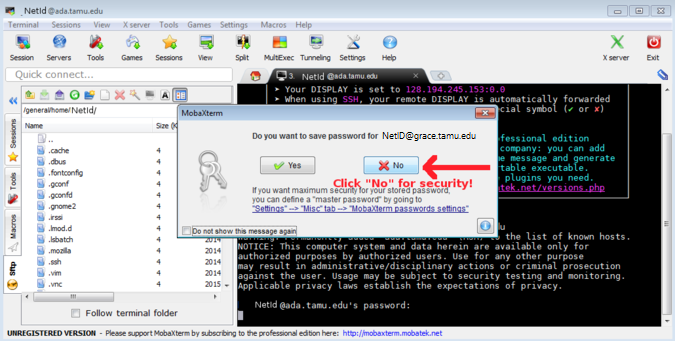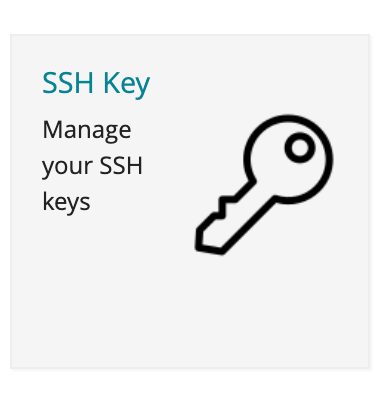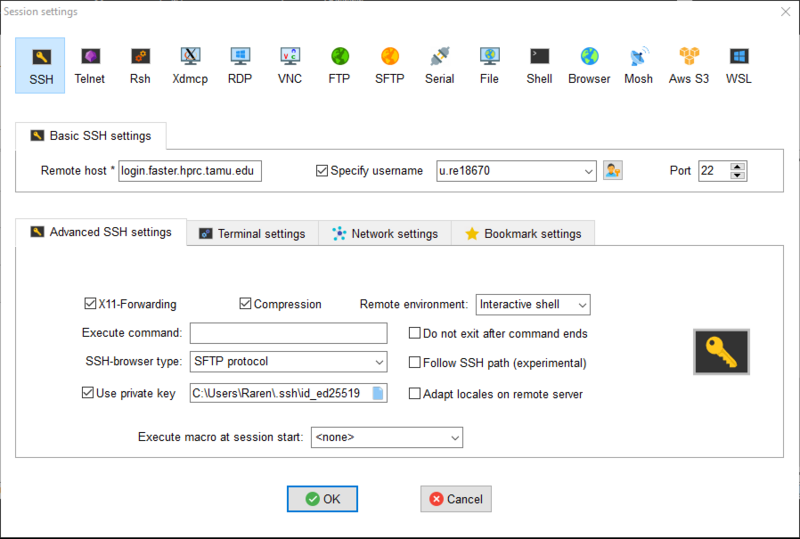FASTER Quick Start Guide
FASTER Usage Policies
Access to FASTER requires that you adhere to all Texas A&M HPRC and FASTER-specific policies.
General policies can be found on the HPRC Policies page.
FASTER User Guide
Please visit the FASTER User Guide for additional documentation.
Getting Started (TAMU)
Researcher accounts on FASTER are managed by the HPRC account system. To apply for or renew an HPRC account, please visit the Account Applications page.
Portal login (TAMU)
Users can log in using the Portal by visiting:
https://portal-faster.hprc.tamu.edu
Please visit the Portal kb page for additional information.
SSH login (TAMU)
To connect to FASTER, you must use SSH (Secure Shell). SSH is a client-server software that provides for secure (by encryption) logins and other communication between two hosts. SSH is freely available on the Internet for Linux/Unix and PC Windows (in the guise of MobaXterm).
To initiate an SSH connection to a FASTER login node from a terminal enter
[username@localhost ~]$ ssh [NetID]@faster.hprc.tamu.edu
where the faster.hprc.tamu.edu address is a DNS round-robin alias for faster[1-{{ numlogin }}].hprc.tamu.edu. You will be prompted for your NetId password to establish authentication. Once you log in successfully, you will land on one of the 2 login nodes. The shell's prompt will show the actual node you logged into, e.g. [NetID].faster1.
If you are connecting for the very first time, you will see a message similar to the following before arriving at the password prompt:
The authenticity of host 'faster (xxx.xx.xx.xx)' can't be established.
ECDSA key fingerprint is SHA256:SfQPtDJW30sj4kG2c4KGFw7LcEduSOFeXGIlsf4WhEA.
ECDSA key fingerprint is MD5:9c:ea:ba:22:0f:6f:1e:b9:0c:21:d4:b6:70:0f:a0:d5.
Are you sure you want to continue connecting (yes/no)?
Type yes and you will then be presented with the password prompt.
Warning: Permanently added 'faster' (ECDSA) to the list of known hosts.
NetID@faster.hprc.tamu.edu's password:
Login Nodes
There are a total of 2 login nodes on FASTER. Connecting to faster.hprc.tamu.edu will direct you to one of the 2 nodes based on a round-robin queue. You can connect to a particular node by utilizing the node-specific names. For example, to connect to FASTER login node 2:
[username@localhost ~]$ ssh [NetID]@faster2.hprc.tamu.edu
MobaXterm Users
MobaXterm is an enhanced terminal for Windows with a built-in X11 server, tabbed SSH client, built-in file editor, SFTP functionality, and other useful features. You may download MobaXterm from: http://mobaxterm.mobatek.net/download.html
You will need to choose which license (free Home edition, or professional) and then select the Portable or Installer edition. The Installer edition works best on your personal machine when you have the privilege to install software. The portable version may be necessary when using a lab workstation, for example. (Be sure to check if MobaXterm is already installed in the Windows Start menu.)
You may create saved sessions for connecting to faster.hprc.tamu.edu. See http://mobaxterm.mobatek.net/documentation.html#1_2 for instructions. For example:

IMPORTANT: When asked if you would like to save your password, choose "No" to avoid potential security exploits or getting locked out of the system when your password is changed.

Off-campus Access
To connect to cluster login nodes from outside the campus, you need to activate Virtual Private Network (VPN) first, then initiate an SSH connection to the cluster login nodes. You can find VPN installation instructions from TAMU ServiceNow Knowledge Base page on VPN.
WSL and Windows Users Attention: There is a known issue with VPN where users using WSL on Windows 11 cannot log into the cluster at this time. You will instead need to use PowerShell.
-
PowerShell: you will use syntax similar to when you use WSL: "ssh[NetID]@faster.hprc.tamu.edu"
-
Shell Access via the portal: you will access portal-faster.hprc.tamu.edu. On the top bar, choose "Clusters" then choose the "Shell Access" option.
Getting Started (ACCESS)
Researcher accounts on FASTER are managed through NSF ACCESS. Note that ACCESS is a national program funded by the National Science Foundation. It is not specific to Texas A&M University.
Getting an ACCESS Account
To get started with ACCESS and set up your ACCESS ID, follow our instructions at Helpful Pages: Getting Started with ACCESS.
Getting an Account on FASTER
Researchers can request an allocation on FASTER through ACCESS.
See the ACCESS "Get your First Project" page in the ACCESS documentation to learn how to apply.
You will also be given temporary access if you register for one of our Training sessions on FASTER.
Portal login (ACCESS)
Authorized ACCESS users can log in using the Web Portal:
https://portal-faster-access.hprc.tamu.edu
To learn more about the Web Portal, please visit the Portal kb page for additional information.
SSH login (ACCESS)
Jump Host
SSH login to FASTER is available through the faster jump host for authorized ACCESS users who have supplied their SSH keys.
[user@localhost ~]$ ssh -J [username]@faster-jump.hprc.tamu.edu:8822 [username]@login.faster.hprc.tamu.edu
You can find your username under your ACCESS profile: https://allocations.access-ci.org/profile
Generating SSH Keys
If you do not already have an ed25519-type key pair, you can use the below instructions to generate your SSH keys on the host you will use to log in from. The keys should automatically be generated in $HOME/.ssh/ Do NOT change the name of the generated keys or the location
Instructions for Windows users
Please use the Windows PowerShell to generate your keys.

Once you have launched the Windows PowerShell App type:
ssh-keygen -t ed25519
The command will output the following text:
Generating public/private ed25519 key pair.
Enter file in which to save the key (C:\Users\username/.ssh/id_ed25519):
If you already have a .ssh directory, the following text will not be displayed.
Created directory 'C:\Users\username/.ssh'.
Hit Enter at the following prompt.
Enter passphrase (empty for no passphrase):
Hit Enter at the following prompt.
Enter same passphrase again:
More text output:
Your identification has been saved in C:\Users\username/.ssh/id_ed25519.
Your public key has been saved in C:\Users\username/.ssh/id_ed25519. pub.
The key fingerprint is:
SHA256:long_string_of_text_here
The key's randomart image is:
(many lines of characters here)
Instructions for Linux and Mac users
Launch a terminal on your Linux or Mac system and type:
ssh-keygen -t ed25519
The command will output the following text:
Generating public/private ed25519 key pair.
Enter file in which to save the key (/home/abhinand/.ssh/id_ed25519):
If you already have a .ssh directory, the following text will not be displayed.
Created directory '/Users/username/.ssh'
Hit Enter at the following prompt.
Enter passphrase (empty for no passphrase):
Hit Enter at the following prompt.
Enter same passphrase again:
More text output:
Your identification has been saved in /Users/username/.ssh/id_ed25519.
Your public key has been saved in /Users/username/.ssh/id_ed25519.pub.
The key fingerprint is:
SHA256:long_string_of_text_here
The key's randomart image is:
(many lines of characters here)
How to submit your id_ed25519.pub key?
The following link has basic instructions on how to login and upload your key:
Here are detailed instructions:
Login to: https://registry.access-ci.org/
Click on “SSH Key: Manage your SSH keys”:

Click on Add SSH Key in the upper right hand corner:

Click Choose File and navigate to the location of your id_ed25519.pub file and click on the open button. Depending on your operating system, you may need to make a copy of your id_ed25519.pub file to another directory if it is in a hidden folder.
Troubleshooting jump host
Corrupted MAC on input:
Users connecting through a Windows shell (cmd/PowerShell) may experince this error:

Adding the option "-m hmac-sha2-512" to your ssh command should resolve this issue:
[user@localhost ~]$ ssh -m hmac-sha2-512 -J [username]@faster-jump.hprc.tamu.edu:8822 [username]@login.faster.hprc.tamu.edu
If issues persist, contact our helpdesk at help@hprc.tamu.edu.
MobaXterm users
MobaXterm offers the capability to use a jump host to connect to a server in a secured network zone. You can configure your SSH session to use a jump host to save time with the login process.
Click on the Session tab to create a new session. Next click SSH* in the top ribbon.
Enter login.faster.hprc.tamu.edu into the Remote host * box.
Enter your ACCESS username in the Specify username box.
Open the Advanced SSH Settings tab and check the Use Private Key box. Then enter the path to your private key.

Go to the Network Settings tab and enable Connect through SSH gateway (jump host) and enter respective login data. The gateway host should be faster-jump.hprc.tamu.edu and the port should be 8822. Click OK.


Start the session by double-clicking the session login.faster.hprc.tamu.edu (username) in the left-hand ribbon or under the Sessions tab.